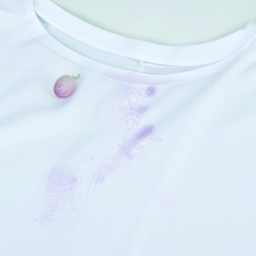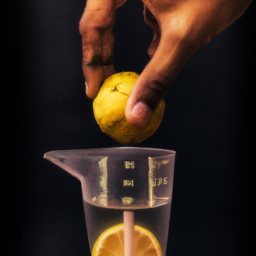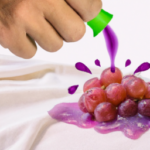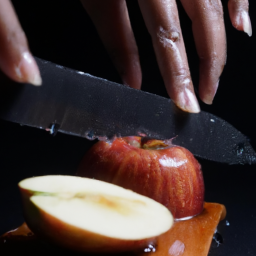We’ve all experienced it: savoring a tasty glass of grape juice only to have it accidentally spill on our clothes. It may feel like a daunting task to clean up, but fear not! By following the proper steps, removing grape juice stains from your clothing can be a simple process.
First, it’s important to act quickly. As soon as the spill happens, grab a cloth and begin blotting the stain. The longer the juice sits, the harder it will be to remove.
Once you’ve blotted as much of the juice as possible, it’s time to move onto the next step: rinsing with cold water.
Keep reading to learn the rest of the steps to effectively remove grape juice stains from your clothes.
Key Takeaways
- Act quickly to remove grape juice stains from clothing
- Soak in cold water and vinegar for at least 30 minutes
- Use stain remover and check care label before washing
- Prevention is key: use stain-resistant fabric spray and wear bib/apron when drinking grape juice
Blot the Stain Immediately
Don’t panic, just grab a paper towel and blot that grape juice stain ASAP! Blotting techniques are essential to get as much of the stain out as possible before it sets in.
Start by gently blotting the stain with a clean and dry paper towel. Avoid rubbing the stain as it can spread the grape juice further into the fabric. Instead, press down on the stain to absorb as much of the juice as possible.
The importance of quick action can’t be stressed enough. The longer you wait to treat the stain, the harder it’ll be to remove.
If you’re out and about and don’t have access to a paper towel, you can use a cloth napkin, a tissue, or even a slice of bread to blot the stain.
Once you’ve blotted the stain as much as possible, move on to the next step and rinse the fabric with cold water.
Rinse with Cold Water
First, start by running icy water over the stained area to prevent the juice from setting into the fabric like a stamp on an envelope. It’s important to use cold water instead of warm or hot water because heat can actually set the stain permanently. Next, gently blot the area with a clean cloth to absorb as much of the juice as possible without rubbing it deeper into the fibers. Afterward, you can apply a stain remover or a mixture of water and a small amount of dish soap to effectively clean juice stains from carpet or fabric. Be sure to test any cleaning solution on an inconspicuous area first to avoid damaging the material.
Here are four benefits of using cold water for stain removal:
- Cold water helps to prevent the stain from spreading.
- It helps to loosen the stain from the fabric.
- It’s gentle on the fabric and won’t cause damage.
- It’s easily accessible and doesn’t require any special equipment.
To properly rinse clothing for stain removal, hold the stained area under a faucet or use a bowl of cold water to pour over the stain. Make sure the water is running through the back of the fabric to push the stain out instead of pushing it further into the fibers.
Once you’ve rinsed the area thoroughly, move on to applying a stain remover.
Applying a stain remover is the next step in removing grape juice from clothes.
Apply a Stain Remover
When it comes to removing tough stains like grape juice from clothes, I’ve found that applying a stain remover can be really helpful.
There are two options when it comes to stain removers: you can use a commercial product or make your own at home.
Commercial stain removers can be found at most stores and are specifically designed to tackle tough stains, while making your own can be a more natural and cost-effective option.
Use a Commercial Stain Remover
To effectively remove grape juice stains from your clothes, you can try using a commercial stain remover that’s specifically designed for tough stains. There are many benefits to using natural stain removers, but sometimes a commercial product is necessary for those stubborn stains.
When choosing a commercial stain remover, it’s important to compare the effectiveness of different products. Look for one that’s specifically designed for removing grape juice stains and has good reviews from other users.
When using a commercial stain remover, always follow the instructions on the label. Apply the remover directly to the stain and let it sit for the recommended amount of time. Then, wash the garment in the washing machine as usual.
If the stain is still visible, repeat the process or try a different product. If you prefer to make your own stain remover, there are several options you can try.
Make Your Own Stain Remover
If you’re feeling crafty, whip up your own stain remover using DIY stain remover recipes that use natural stain removal techniques.
One common recipe is to mix equal parts baking soda and water to form a paste. Spread the paste on the stained area, let it sit for 30 minutes, and then rinse it off with cold water.
Another recipe is to mix 1/4 cup of white vinegar, 1 tablespoon of dish soap, and 2 cups of water. Apply the mixture to the stain, let it soak for 15 minutes, and then rinse it off with cold water.
These DIY stain remover recipes are effective, affordable, and eco-friendly. They use simple ingredients that you probably already have in your kitchen, and they don’t contain any harsh chemicals.
So next time you spill grape juice on your clothes, don’t panic. Just mix up a batch of DIY stain remover and treat the stain with natural stain removal techniques.
Once you’ve applied the stain remover, move on to the next step: soak the stain in cold water for at least 30 minutes to help lift the remaining stain from the fabric.
Soak the Stain
First, try soaking your stained clothes in cold water and vinegar to help lift the grape juice from the fabric. This is one of the pre-treatment options that you can do before washing your clothes.
Simply fill a basin or sink with cold water and add a cup of vinegar. Then, place the stained clothing into the water and let it soak for at least 30 minutes. The vinegar will help break down the stain while the cold water prevents the stain from setting further into the fabric.
If the grape juice stain is particularly stubborn, you may need to try alternative stain removal techniques such as using a specialized stain remover or laundry detergent. However, before trying any harsh chemicals on your clothing, always refer to the manufacturer’s instructions and test on a small, inconspicuous area first.
Once you have successfully soaked and treated the grape juice stain, it is time to wash the clothing as usual.
Wash the Clothing
Now it’s time to toss those stained clothes in the washing machine and say goodbye to that pesky grape juice stain for good! But wait, before you do that, it’s important to know some stain removal and laundry techniques to ensure that the stain is completely removed.
First, check the care label on your clothing to determine the appropriate water temperature and washing cycle. Then, pretreat the stain with a stain remover or laundry detergent before placing it in the machine. For tougher stains, you may need to soak the clothing in a mixture of warm water and laundry detergent for a few hours before washing.
To better understand how to remove grape juice stains, take a look at the table below. It provides a quick and easy guide on how to treat stains based on the type of fabric.
| Fabric Type | Treatment |
|---|---|
| Cotton | Pretreat with laundry detergent and wash on warm |
| Synthetic | Pretreat with stain remover and wash on cold |
| Wool | Soak in cold water and use a wool-specific stain remover before washing on cold |
| Silk | Spot clean with a gentle fabric cleaner and air dry |
Now that you know how to properly wash your stained clothing, it’s time to check the stain after washing to ensure that it’s completely gone.
Check the Stain
After tossing your stained clothing in the washing machine, don’t forget to double-check for any lingering traces of the grape juice stain.
Grape juice stains are notorious for being difficult to remove, so it’s important to identify any remaining marks before putting the clothing in the dryer. To identify grape juice stains, look for a dark purple or red spot on the fabric. The stain may also feel sticky or have a sweet smell.
When dealing with grape juice stains, it’s important to take precautions to avoid spreading the stain. Avoid rubbing the stain, as this can cause it to spread and set deeper into the fabric. Instead, gently blot the stain with a clean cloth or paper towel to remove as much of the juice as possible.
If the stain is still visible, apply a stain remover or a mixture of vinegar and baking soda before washing the clothing again. With these precautions in mind, you can successfully remove grape juice stains from your clothing.
Moving on to the next step, repeating the process, it’s important to continue checking for any remaining traces of the stain until it is completely gone.
Repeat the Process
To ensure that every last bit of the grape juice stain is removed, I suggest checking the clothing and repeating the process until the fabric is completely clean and free of any lingering marks. Repetition benefits the cleaning process, as it gives the cleaning agent enough time to work on the stain and break it down.
If the first attempt does not fully remove the grape juice stain, try applying the cleaning solution again and letting it sit for a longer period of time. Alternatively, you can also try using a different cleaning solution, such as rubbing alcohol or white vinegar, to remove the grape juice stain from the clothing.
Make sure to spot test the solution on an inconspicuous area of the fabric before applying it to the stained area. Once the grape juice stain is removed, it’s important to dry the clothing properly to prevent any mildew or mold growth.
Dry the Clothing
Once the stain has been fully removed, make sure to properly dry the clothing to avoid any potential for mildew or mold growth. It’s better to be safe than sorry! When it comes to drying grape juice stains on clothes, there are two main options: air dry or tumble dry.
Air drying can be a great option for delicate fabrics or if you’re worried about shrinkage. Simply lay the garment flat on a clean towel and let it dry naturally. However, if you’re in a rush or prefer to use a dryer, tumble drying can also work well. Just make sure to use a low heat setting and avoid over-drying the clothing.
| Best Techniques for Drying Grape Juice Stains on Clothes | Tips for Preventing Grape Juice Stains from Setting in Clothes |
|---|---|
| Option 1: Air dry | Use a stain-resistant fabric spray before wearing clothes |
| Lay garment flat on clean towel | Use a bib or apron when drinking grape juice |
| Allow to dry naturally | Treat stains as soon as possible |
| Option 2: Tumble dry | Blot stains with a clean cloth or paper towel before washing |
| Use a low heat setting | Avoid rubbing stains, as this can push them further into the fabric |
After drying the clothing, it’s important to check for any residual stains. Even if the stain appears to be fully removed, it’s possible that some pigment may still be present. In the next section, we’ll explore techniques for ensuring that the stain is completely gone.
Check for Residual Stains
Make sure you don’t miss this crucial step – checking for any remaining stains on your clothing after removing grape juice stains. Grape juice stains can come in different types, such as fresh or dried, and they can be quite stubborn to get rid of.
Even if you think you’ve successfully removed the grape juice stain, it’s important to check for any residual stains that may still be present. The importance of checking for residual stains lies in preventing the stain from becoming permanent. If left untreated, the stain may set in and become more difficult to remove.
So, make sure to examine your clothing thoroughly for any remaining grape juice stains before proceeding to the next step. Speaking of which, let’s move on to some prevention tips to avoid getting grape juice stains in the first place.
Prevention Tips
Want to avoid getting those pesky purple stains on your favorite clothes? Here are some tips to prevent grape juice stains from happening in the first place!
First, consider investing in stain-resistant fabrics. These fabrics are designed to repel liquids and prevent stains from setting in. Look for clothing made from materials like polyester or nylon, which are known for their stain resistance properties.
If you do find yourself in a situation where grape juice is the only option, try using grape juice alternatives like cranberry or pomegranate juice. These juices have a similar taste and color to grape juice but are less likely to leave behind stains.
Another option is to dilute the grape juice with water to reduce its staining potential. And if all else fails, be sure to treat any stains immediately with a stain remover before washing the garment.
Frequently Asked Questions
Can grape juice stains be removed from all types of fabrics?
Fabric compatibility is key when removing grape juice stains. There are alternative solutions for each type of fabric, but it’s important to act fast. With attention to detail, any stain can be removed with ease.
How long should the stain be soaked in stain remover before washing?
When it comes to removing tough stains from clothes, stain remover effectiveness and soaking time are key. It’s important to follow the instructions on the product, but I’ve found that soaking for at least 30 minutes before washing yields the best results.
What is the best type of stain remover to use for grape juice stains?
When dealing with grape juice stains, chemical stain removers tend to be more effective than natural ones. However, DIY options like vinegar or baking soda can work well if used immediately and in large quantities.
Can hot water be used to rinse out the stain instead of cold water?
As the saying goes, "hot water sets stains."Using hot water for grape juice stains can actually make it worse. It’s best to pre-treat the stain before washing with cold water and stain remover.
How can I prevent grape juice stains from occurring in the first place?
To prevent grape juice stains, I avoid wearing light-colored clothes while drinking it. If spilled, I immediately blot the stain with a paper towel and apply a mixture of vinegar and dish soap. Alternative solutions include using a stain repellent spray or wearing a bib.
Conclusion
Well, that was quite a spill! I was enjoying a nice glass of grape juice when suddenly, it ended up all over my shirt. Luckily, I remembered the steps to remove the stain.
First, I made sure to blot the stain immediately with a clean cloth to absorb as much of the juice as possible. Then, I rinsed the affected area with cold water to prevent the stain from setting in.
Next, I applied a stain remover and let it sit for a few minutes before soaking the stain in cold water overnight. The next day, I washed the clothing in the washing machine and repeated the process if necessary.
Once the stain was removed, I made sure to dry the clothing thoroughly and checked for any residual stains.
In the future, I’ll be sure to use a bib or be more careful when drinking grape juice to prevent any more spills. But for now, I’m happy to have successfully removed the stain thanks to these helpful steps.
Cindy thoroughly researches juicing trends, techniques, and recipes to provide readers with practical advice and inspiration. Her writing style is accessible, engaging, and designed to make complex concepts easy to understand. Cindy’s dedication to promoting the advantages of juicing shines through her work, empowering readers to make positive changes in their lives through the simple act of juicing.

















